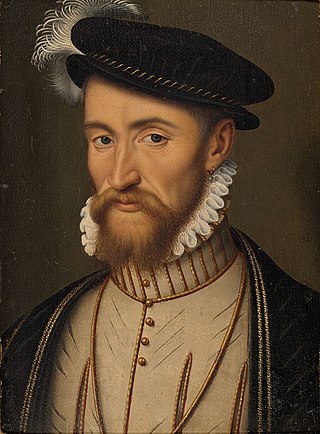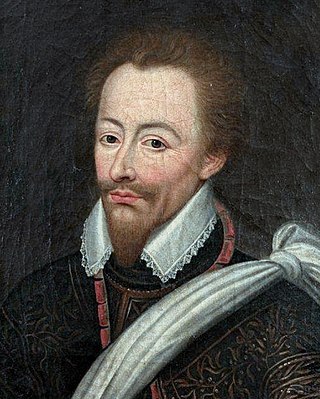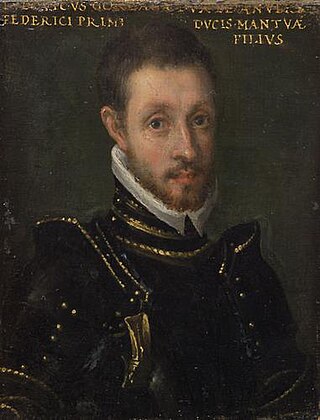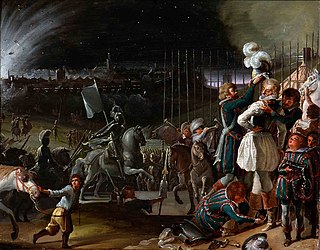
The French Wars of Religion refers to the period of civil war between French Catholics and Protestants from 1562 to 1598. Between two and four million people died from violence, famine or disease directly caused by the conflict, and it severely damaged the power of the French monarchy. One of its most notorious episodes was the St. Bartholomew's Day massacre in 1572. The fighting ended with a compromise in 1598, when Henry of Navarre, who had converted to Catholicism in 1593, was proclaimed King Henry IV of France and issued the Edict of Nantes, which granted substantial rights and freedoms to the Huguenots. However, Catholics continued to disapprove of Protestants and of Henry, and his assassination in 1610 triggered a fresh round of Huguenot rebellions in the 1620s.

Philips of Marnix, Lord of Saint-Aldegonde, Lord of West-Souburg was a Flemish and Dutch writer and statesman, and the probable author of the text of the Dutch national anthem, the Wilhelmus.

Francis I of Lorraine, 2nd Duke of Guise, 1st Prince of Joinville, and 1st Duke of Aumale, was a French general and statesman. A prominent leader during the Italian War of 1551–1559 and French Wars of Religion, he was assassinated during the siege of Orleans in 1563.

Henri de Bourbon, 2nd Prince of Condé was a French prince du sang and Huguenot general like his more prominent father, Louis I, Prince of Condé.

The Anglo-Spanish War (1585–1604) was an intermittent conflict between the Habsburg Kingdom of Spain and the Kingdom of England that was never formally declared. It began with England's military expedition in 1585 to what was then the Spanish Netherlands under the command of the Earl of Leicester, in support of the Dutch rebellion against Spanish Habsburg rule.

Henri de La Tour d'Auvergne was a member of the powerful House of La Tour d'Auvergne, Prince of Sedan and a marshal of France.

Charles de Lorraine, duc d'Aumale was a French noble, military commander and governor during the latter French Wars of Religion. The son of Claude, Duke of Aumale and Louise de Brézé, Aumale inherited his families position in north eastern France, and his fathers title of Grand Veneur. Educated as a fervent Catholic, his clients engineered the creation of the first national Catholic Ligue in 1576, and he continued to support the remnants of the organisation after the Treaty of Bergerac caused much of the ligue to dissolve. During the sixth civil war that the ligue had induced, he fought with the king's brother Alençon at the sieges of La Charité-sur-Loire and Issoire. During the seventh civil war in 1579, he brought his ligueur forces to support the royal army under Marshal Matignon during the siege of La Fère but left on bitter terms with the commander when the siege was brought to a close on generous terms.

Pedro Henriquez d'Azevedo y Alvarez de Toledo, Count of Fuentes de Valdepero was a Spanish general and statesman.
The Edict of Boulogne, also called the Edict of Pacification of Boulogne and the Peace of La Rochelle, was signed in June 1573 by Charles IX of France in the Château de Madrid in the Bois de Boulogne. It was officially registered by the Parlement of Paris on 11 August 1573. The treaty officially ended the fourth phase of the French Wars of Religion.

Louis de Gonzague, Duke of Nevers was a soldier, governor and statesman during the French Wars of Religion. His father and brother were reigning dukes of Mantua. He came to France in 1549, and fought for Henri II of France during the latter Italian Wars, getting himself captured during the battle of Saint Quentin. Due to his Italian connections he was seen as a useful figure to have as governor of French Piedmont, a post he would hold until Henri III ceded the territory in 1574. In 1565 his patron, Catherine de' Medici secured for him a marriage with the key heiress Henriette de Clèves, elevating him to duke of Nevers and count of Rethel. He fought for the crown through the early wars of religion, receiving a bad injury in the third war. At this time he formed a close bond with the young Anjou, future king Henri III, a bond that would last until the king's death.

The surprise of Meaux was a failed coup attempt by leading aristocratic Huguenots which precipitated the second French War of Religion. Dissatisfied with their lot, and under the pretext of fear of extermination, Louis, Prince of Condé and Gaspard II de Coligny plotted to seize the king, Charles IX, while he was staying near Meaux. Alerted by the mustering of the Huguenots, the royal court made a dash for Paris, fighting off attempts to break through to them en route. Their plan foiled, the Huguenots laid siege to the city, beginning the second war. The event would be of lasting importance in the reputation it gave its architects for sedition.

The siege of Paris took place during the French Wars of Religion when the French Royal Army under Henry of Navarre, and supported by the Huguenots, failed to capture the city of Paris from the Catholic League. Paris was finally relieved from the siege by an international Catholic-Spanish army under the command of Alexander Farnese, Duke of Parma.

The Battle of Craon took place between 21–24 May 1592, between the French Royal army under the Duke of Montpensier and François de Bourbon, Prince of Conti, reinforced by English contingents under Sir John Norreys, against the combined forces of Spain, during their occupation of Brittany, and the Catholic League of France during the War of the Three Henrys and the Anglo-Spanish War (1585–1604), in the context of the French Wars of Religion. Craon was besieged by the army of Henry of Navarre, but the defenders, supported by a Catholic relief force recruited by Philippe Emmanuel, Duke of Mercœur, resisted. At the end, Craon was relieved by the Spaniards under Don Juan del Águila, who defeated the Anglo-French besiegers.

The siege of Amiens was a siege and battle fought during the Franco-Spanish War (1595–1598), as part of both the French Wars of Religion and the Anglo-Spanish War (1585–1604), between 13 May and 25 September 1597. The Spanish, who had sent a large army in March, had captured the city of Amiens easily in a ruse. Henry IV of France, after the surprise of the capture, immediately and quickly built up an army which included a large English force and besieged Amiens on 13 May.

The siege of Calais of 1596, also known as the Spanish conquest of Calais, took place at the strategic port-city of Calais, between 8 and 24 April 1596, as part of the Franco-Spanish War (1595–1598), in the context of the French Wars of Religion, the Anglo-Spanish War (1585–1604), and the Eighty Years' War. The siege ended when the city fell into Spanish hands after a short and intense siege by the Spanish Army of Flanders commanded by Archduke Albert of Austria, Governor-General of the Spanish Netherlands. The French troops in the citadel of Calais resisted for a few days more but finally, on 24 April, the Spanish troops led by Don Luis de Velasco y Velasco, Count of Salazar, assaulted and captured the fortress, achieving a complete victory. The Spanish success was the first action of the campaign of Archduke Albert of 1596.

The siege of Doullens, also known as the Spanish capture of Doullens or the Storming of Doullens, took place between 14 and 31 July 1595, as part of the Franco-Spanish War (1595-1598), in the context of the French Wars of Religion. After ten days of siege, on 24 July, the combined forces of Henri de La Tour d'Auvergne, Duke of Bouillon, André de Brancas, Amiral de Villars, and François d'Orléans-Longueville, tried to relieve the city, but were severely defeated by the Spanish forces led by Don Pedro Henríquez de Acevedo, Count of Fuentes, and Don Carlos Coloma. Villars was taken prisoner and executed, and the Duke of Bouillon fled to Amiens with the rest of the French army. Finally, a few days after, on 31 July, the Spanish troops stormed Doullens. The Spaniards killed everybody in the city, military and civilians alike, shouting "Remember Ham"(Spanish: "Recordad Ham"), in retaliation for the massacre against the Spanish garrison of Ham by the French and Protestant soldiers under Bouillon's orders.

The Battle of the Lippe was a cavalry action fought on 2 September 1595 on the banks of the Lippe river, in Germany, between a corps of Spanish cavalry led by Juan de Córdoba and a corps of Dutch cavalry, supported by English troops, led by Philip of Nassau. The Dutch stadtholder Maurice of Nassau, taking advantage of the fact that the bulk of the Spanish army was busied in operations in France, besieged the town of Groenlo in Gelderland, but the elderly governor of the citadel of Antwerp, Cristóbal de Mondragón, organized a relief army and forced Maurice to lift the siege. Mondragón next moved to Wesel, positioning his troops on the southern bank of the Lippe river to cover Rheinberg from a Dutch attack. Maurice aimed then, relying on his superior army, to entice Mondragón into a pitched battle, planning to use an ambush to draw the Spanish army into a trap. However, the plan was discovered by the Spanish commander, who organized a counter-ambush.

The siege of Huy of 1595, also known as the assault of Huy, took place between 7 and 20 March 1595, at Huy, Archbishopric of Liège, Low Countries, as part of the Eighty Years' War and the Anglo-Spanish War (1585–1604). It concluded in a Spanish victory.

The siege of Hulst of 1596 took place between mid-July and August 18, 1596, at the city of Hulst, Province of Zeeland, Low Countries, during the Eighty Years' War, the Anglo-Spanish War (1585–1604). The siege was won by the Spanish forces of the Archduke of Austria. After a short siege, during which Maurice of Orange launched a failed attempt to relieve the city, the garrison of Dutch and English troops fell into Spanish hands on August 18, 1596.
The Luxemburg campaigns were two military campaigns by the Dutch Republic and the Duchy of Bouillon against the Spanish Southern Netherlands during the Eighty Years' War in 1593 and 1595. The first was undertaken by a Dutch States Army commanded by Philip of Nassau to the Duchy of Luxemburg in early 1593, with the aim of distracting the Spanish Army of Flanders to a different part of the Habsburg Netherlands, create confusion and block the importation of new pro-Spanish troops to the Low Countries via the Spanish Road. Other goals were dealing economic damage to Spain, and supporting the Protestant claimant to the French throne Henry of Navarre and the Protestant prince of Sedan and duke of Bouillon, Henry de La Tour d'Auvergne.

















